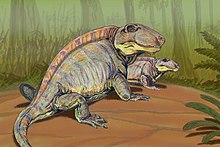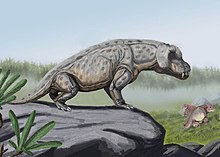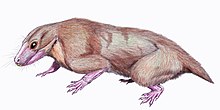Synapsids
| Synapsids | ||||||||||
|---|---|---|---|---|---|---|---|---|---|---|

Reconstruction of Edaphosaurus pogonias |
||||||||||
| Temporal occurrence | ||||||||||
| Upper carbon to recent | ||||||||||
| 308 to 0 million years | ||||||||||
| Locations | ||||||||||
|
||||||||||
| Systematics | ||||||||||
|
||||||||||
| Scientific name | ||||||||||
| Synapsida | ||||||||||
| Osborn , 1903 |
The synapsids (Synapsida, "synapsid" - "fused arch"; also Theromorpha ) are one of the two large groups of amniotes . The eponymous feature is a single skull window in the posterior side wall of the skull ( temple or temporal window ). The synapsids emerged in the late Carboniferous and experienced their first bloom in the subsequent Permian and Triassic geological ages . After the dinosaurs became extinct , they experienced a second bloom with the radiation of mammals from the Paleocene , which continues to this day. The modern mammals represent the only line of the first synapsid bloom that has survived to this day.
According to the traditional view, the Synapsida are a subclass of the reptiles (Reptilia), which includes the orders of the pelycosaurs (Pelycosauria) and the therapsids (Therapsida), descendants of the pelycosaurs and ancestors of the mammals (Mammalia). This traditional concept of reptiles no longer exists in the modern, cladist-based system of terrestrial vertebrates. Instead, a distinction is made between two main lines of development of amniotes ( clades ), synapsids and sauropsids - the latter include the recent representatives of the former "reptiles" and the relatives deep within their standing birds .
features
The name of the group of synapsids is derived from the individual temple window ( temporal window ), which is framed by the skull bones Jugale, Quadratojugale , Squamosum and Postorbitale. The quadratojugale is only present in the most primitive pelycosaurs. It is already reduced in the higher pelycosaurs and the rear part of the temporal window is completely framed by the squamosum. The skull window offered more space for the jaw muscles and also reduced the weight of the skull. In the younger synapsids (“higher” therapsids and mammals) it is no longer recognizable as such due to further evolutionary changes in the structure of the skull. The bone bridge from Squamosum and Jugale, which formed the lower limit of the skull window of the pelycosaurs, is still present in mammals in the form of the zygomatic arch .
The earliest synapsids (pelycosaurs) looked and probably lived like typical reptiles. Later forms (Therapsiden) developed a faster metabolism and thus a constant internal body temperature ( endothermia ), a secondary palate that enabled them to eat and breathe at the same time, a gland-rich, partly hairy skin and differentiated dentition with incisors, canines and molars . In addition, the posture changed: while many recent reptiles have legs spread to the side, those of the later synapsids (therapsids) stood under the body from around the Middle Permian (around 270 million years ago) and carried it relatively far from the ground. So they could run faster and with more stamina.
The lower jaw of an early synapsid (pelycosaur) consists of several bone elements that have grown together, one of which, the dental one, carries the teeth. In the course of evolution, the proportion of the dental part of the lower jaw increased steadily and the remaining elements, the so-called postdental bones , became smaller and smaller, until the lower jaw of the real mammals finally consisted entirely of the dental part. In mammals, one of the postdental bones, the articular bone, is transformed into an ossicle , the hammer (malleus), and is located in the inner ear .
Systematics and evolution

The early synapsids of the Upper Carboniferous and Lower Permian were traditionally combined in the Pelycosauria group. The more modern forms of the Higher Permian and Mesozoic Era were called therapsids , although mammals were traditionally not included in either the synapsids or the therapsids.
According to the modern view, the Synapsida, Pelycosauria and Therapsida of the traditional system are paraphyletic , since they do not include all descendants of their common ancestors. While the Synapsida and Therapsida were redefined as clade in the modern, cladist-based systematics and now also include mammals, the name “Pelycosauria” is only used informally and not as a systematic group name for the earliest synapsids, because when the Rules of the phylogenetic system is a synonym for Synapsida, but the name "Synapsida" is older and therefore has priority .
Representatives of the Pelycosaurier are for example Dimetrodon , Sphenacodon and Edaphosaurus . Dimetrodon , a carnivore, and Edaphosaurus , a herbivore, were equipped with a dorsal sail that, despite their size (up to 3.50 m in length), allowed them to regulate their body temperature relatively quickly. The back sail is interpreted as a clear indication that the pelycosaurs were still “cold-blooded” ( ectothermal ). Pelycosaurs are only known from the Upper Carboniferous and Lower Permian of North America and Europe.
At the turn from lower to middle Perm , the pelycosaurs disappear and the first therapsids appear. They also occur outside of North America and Europe: the Dinocephalians or Anomodontier with their compact bodies and the Theriodontia ("mammalian teeth"), which are relatively "graceful" forms.
Many of the Permian Therapsids fell victim to the mass extinction on the Perm-Triassic border , but some lines survived, including the heavily built herbivorous Dicynodontia (Greek: "two dog teeth", ie animals with two canine teeth, but rather small Tusks are to be addressed) from the group of Anomodontians, with a horned beak instead of the incisors (e.g. Lystrosaurus ) and the smaller, mostly carnivorous cynodontia ("dog teeth") from the group of Theriodontia, with a body length of no more than one meter ( Cynognathus , Thrinaxodon ), which were hairy and warm-blooded (endothermic) at the latest in the Triassic . The first early mammals finally emerged from the ranks of the cynodontic animals towards the end of the Triassic . All Therapsid lines, with the exception of the “real” mammals, died out in the further course of the Mesozoic Era, presumably due to competition from the dinosaurs . Only after the extinction of the dinosaurs at the Cretaceous-Tertiary border did the synapsids in the form of mammals once again become a dominant, very species-rich group of vertebrates.
Internal system
- Synapsida
See also
literature
- Thomas S. Kemp: The Origin & Evolution of Mammals. Oxford University Press, Oxford 2005. ISBN 0-19-850761-5 .
- Robert L. Carroll : Paleontology and Evolution of the Vertebrates. Thieme-Verlag, Stuttgart, 1993, ISBN 3-13-774401-6 .
- Oskar Kuhn: The mammal-like reptiles (therapsids). Neue Brehm Bücherei, A. Ziemsen Verlag, Wittenberg 2003 (reprint of the first edition from 1970), ISBN 3-89432-797-9 .
Web links
- Autapomorphies of the subgroups of basal synapsids (English)
- Mikko's archive of phylogenetics (English)
- palaeos.com (English)
- The collection of non-mammaler synapsids in Chicago Field Museum (English)
Individual evidence
- ^ MJ Benton: Vertebrate Paleontology. 3rd ed., Blackwell Science Ltd., Oxford 2005 ISBN 0-632-05637-1 .
- ^ RL Carroll: Vertebrate Paleontology and Evolution. New York: WH Freeman & Co. 1988 ISBN 0-7167-1822-7 .







